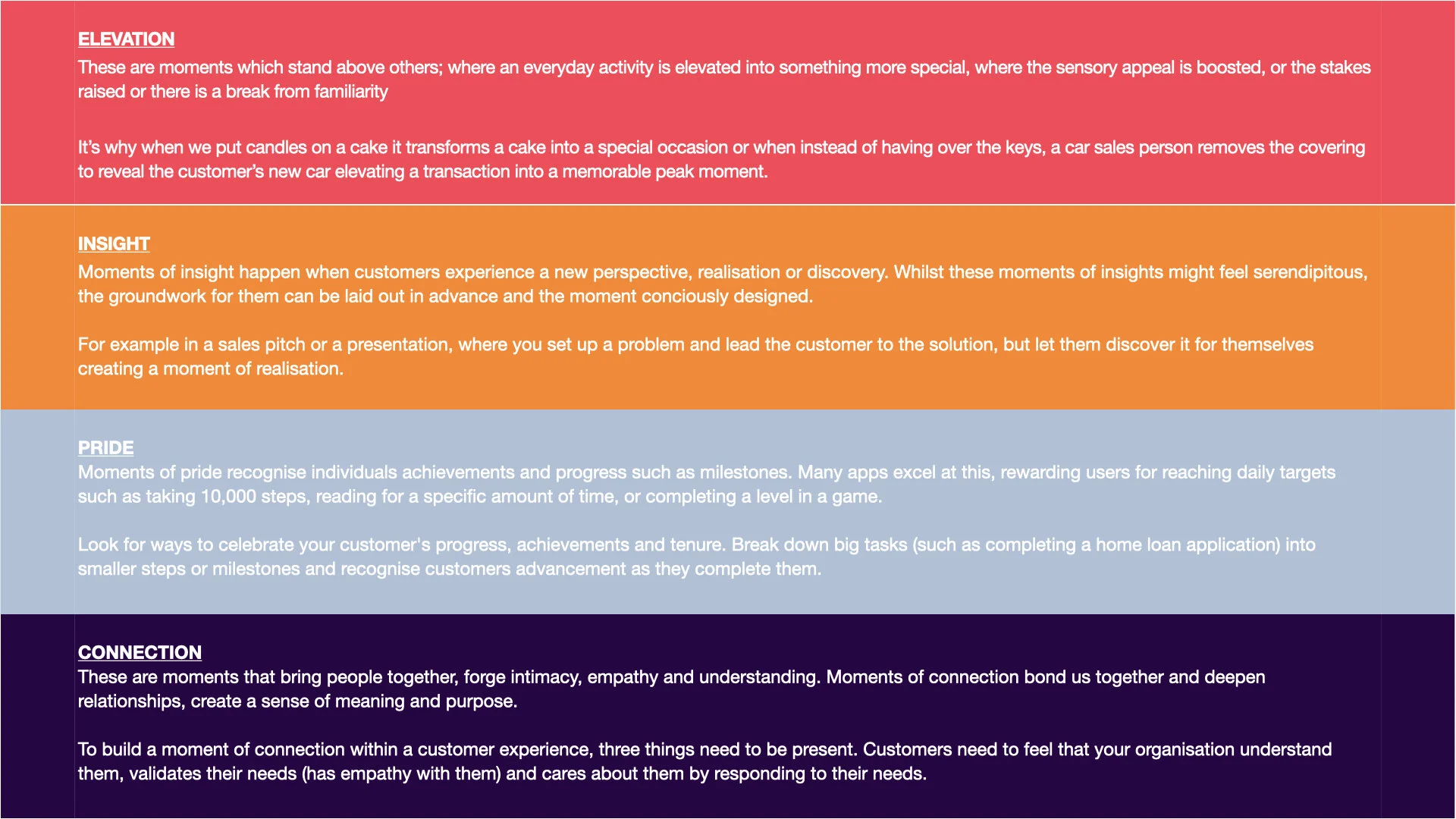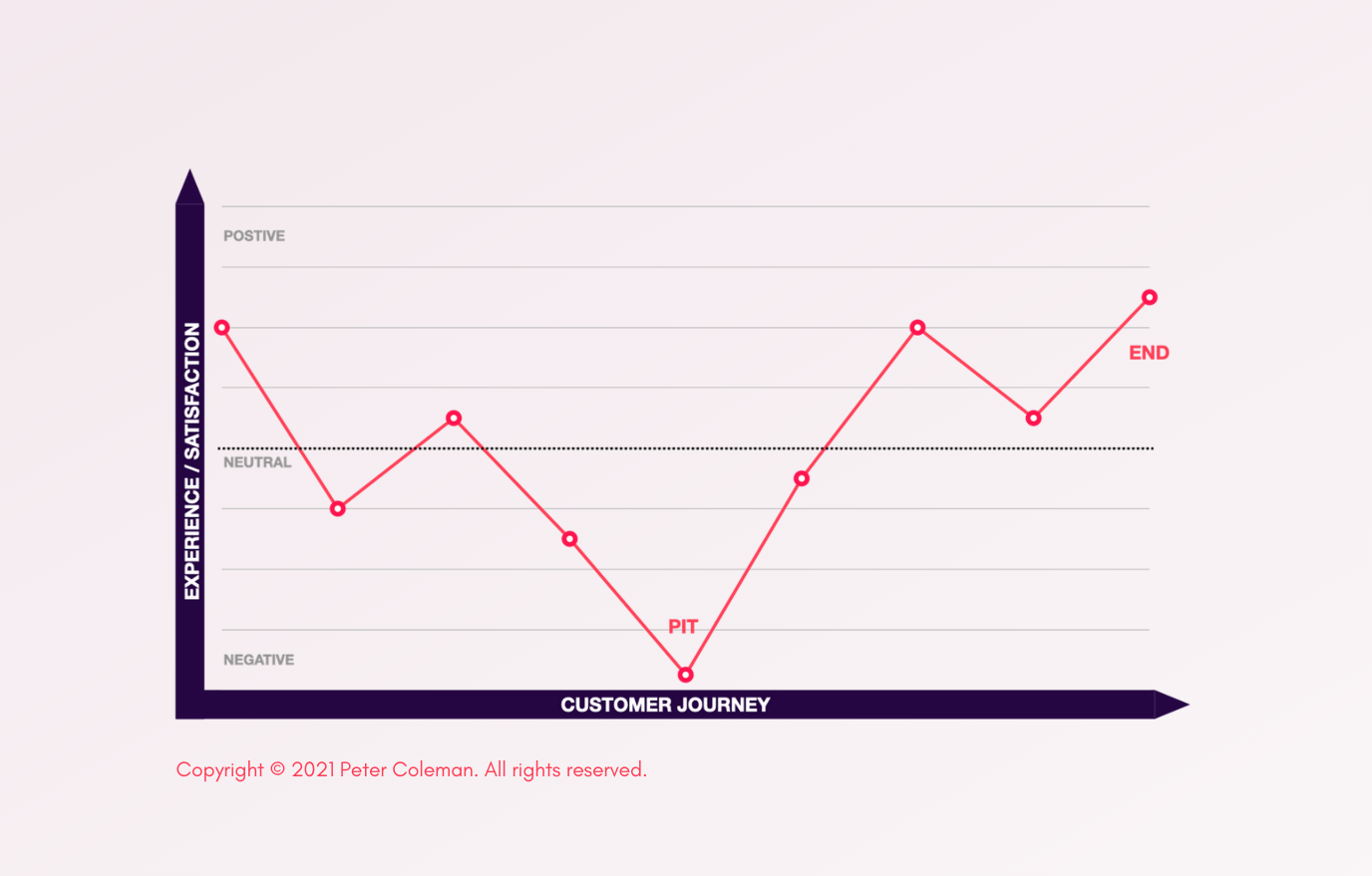THE PEAK-END RULE: THE MOMENTS THAT MATTER MOST IN CX
Photo by Joshua Earle on Unsplash
What is the peak-end rule?
The peak-end rule is a behavioural science theory put forward by psychologists Daniel Kahneman and Barbara Frederickson who discovered that cognitive bias changes how people recall past events. Following a series of experiments, they found that:
“People’s memories are formed largely based on how they felt at the most intense part of an experience and how they felt at the end or conclusion of the experience, rather than the total sum or average of how they felt throughout an experience.”
Frederickson & Kahneman (1993), Journal of Personality and Social Psychology.
Not all moments are created equal
The peak-end rule tells us is that not all parts of a customer experience are remembered equally. Individuals demonstrate better memory for events that are more emotionally intense and recency bias causes individuals to more easily remember something that has happened recently.
Therefore, instead of taking an average of all the moments throughout an experience, individuals remember a few stand out (peak) moments and their feeling at the end.
If you were to ask someone about their experience watching a 90-minute soccer game, they will recount the goals, fouls, penalties, missed opportunities and whether their team won or lost. What they will not describe is the remaining 80 minutes of watching players running up a down the pitch passing the ball around.
These peak moments can be positive or negative memories, and it is these moments and how the customer feels at the end of their journey that shape their perception of an experience the most.
Why the peak-end rule matters in customer experience
Customer experience management often focuses on the removal of friction in the customer journey, obsessing over all of the interactions and delivering improvements. However, if a customers recollection of their experience is limited to its highs, lows and its end-point, then many of these efforts will have been wasted.
Understanding the peak-end moments within your customer journey allows you to identify the moments and interactions that matter most to your customers and where you can make the greatest impact.
Furthermore, the peak-end rule helps prioritise where to focus your finite resources to obtain the best outcome and return on investment.
What creates a peak moment?
A peak moment in a customer journey is the pinnacle or the low-point in a customer journey. The moment where the customer experiences the strongest emotions.
A positive peak moment leads to customers feeling appreciated, confident, grateful, happy, respected or valued. It is these emotions which have been found to improve loyalty the most.*
Whilst qualities such as reliability, dependability and competency may help you meet your customer expectations they rarely create memorable moments. To do so, you need to exceed customer expectations and give them something distinctive to remember your brand or organisation by.
*Source: Forrester Research, US Customer Research Index (2016).
How to create peak-moments
In the book, The Power of Moments, brothers Chip & Dan Heath's research reveals that to create a peak moment it should include elements of the following:
Elevation
Insight
Pride
Connection
The value of building peak moments
Building peaks in the customer journey can lead to an increase in customer satisfaction. Forrester Research found that across a number of categories, highly-satisfied customers spent nine times more* than customers with average satisfaction scores.
They concluded that there was significantly more to gain by elevating positive customer experiences than by eliminating negative experiences.
However, as all companies are different, before embarking on a CX strategy to build peaks or eliminate negative moments it is worth calculating the value to be gained from targeting different customer segments (customers with poor/average/good experiences) and make an informed decision on the return on investment by improving their experience.
*Source: Forrester Research, US Customer Research Index (2016).
The challenge of creating peak moments
The reality of creating memorable moments is that they can be hard to implement. This is because they require breaking from the status quo, financial and human resources to realise and likely are not the organisations top priority. As a result, they become easy to delay or water down.
To create memorable experiences requires determination and effort to prove their value, win over stakeholders and ensure the result is memorable for the customer.
To make the creation of peak moments more palatable, testing the idea out on with a small group of customers can be an effective way to trial the peak moment, gain results to support your initiative and feedback to help further refine and enhance your peak moments.
Managing pits
The opposite of a positive peak-moment in a customer experience is the negative peak: a pit. This is the worst moment in the customer journey when customers expectations are not met and their hopes are dashed leaving them to feel annoyed, disappointed or frustrated.
Managing pits is critical for customer experience. Negative memories are recalled more vividly than positive ones. So it makes sense to understand the causes of any pits in your customer experience and prioritise their resolution. Often, a positive experience can result from the successful resolution of a customer service failure.
Ending on a high
The second most important part of the peak-end rule is how the experience ends. A favourable ending to a customer’s experience will form a lasting positive impression in their minds. It’s why Ikea place their ice cream and hot dog counters after the checkout - it’s the last step in the journey of purchasing new furniture, and a reward that makes the experience end on a happy note and doesn’t add any cost to the business.
When designing your customer experience, consider how you want your users to feel after they complete their task, transaction, meeting. Do they need to feel reassurance about their choice, or anticipation for their visit following a booking, or recognition in completing a task, or thanking for making a decision?
MailChimp recognises the importance of the final step their customers take when using the platform to send email campaigns and use simple graphics to elevate the moment and give their customers a sense of pride in completing their task.
Peak-end strategies to apply:
To determine which peak-end strategy to use, map out your customer experience and assess whether there are any distinct peaks or pits and where your endpoint lies. Then:
If there is a significant pit(s), start by filling it/them
If your endpoint is low, look at how you can improve customers last moment so their final thoughts are positive ones
If there is no discernible peak, consider how you can create a unique moment that customers will value
The result you want is to remove any substantial pits and ensure that there is a key peak moment in the experience and a positive endpoint to frame the experience around.
An ideal peak-end customer should look something like the below. Note that whilst there are still some negative moments, they are not extreme pits and are outweighed by the singular peak moment and high emotional ending.
Key takeaways from the peak-end rule:
Customers remember their experience by the peak moments and how they feel at the end
Identifying and managing the peak and end moments within a customer journey will have the most impact on their experience
CX efforts should focus both on minimising pits and maximising peaks
Peak moments are a great place to insert your brand and create a differentiated experience to your competitors
Depending on customer value, accentuating peaks for satisfied customers can generate a higher return than removing pain points for lower value customers






